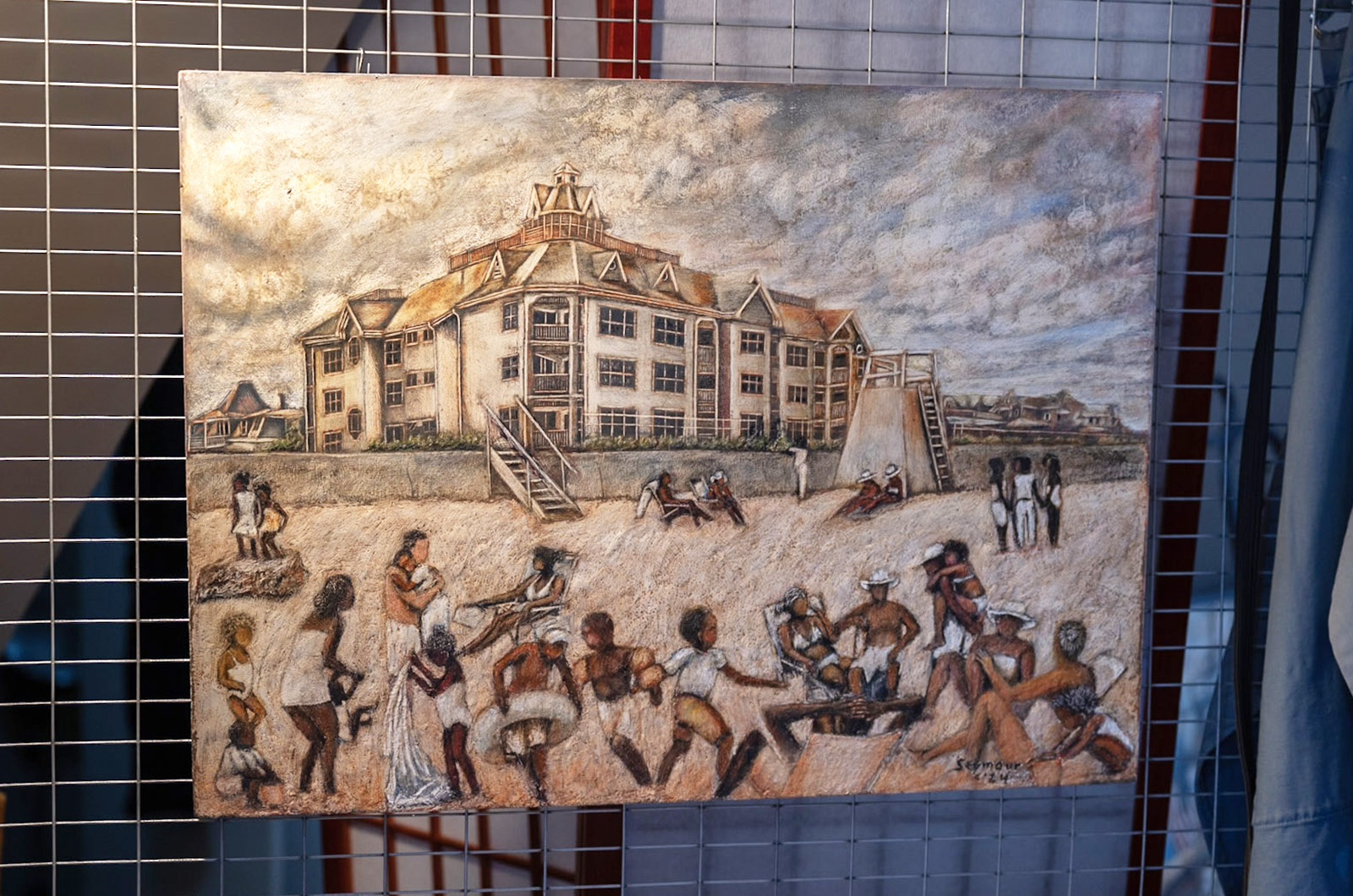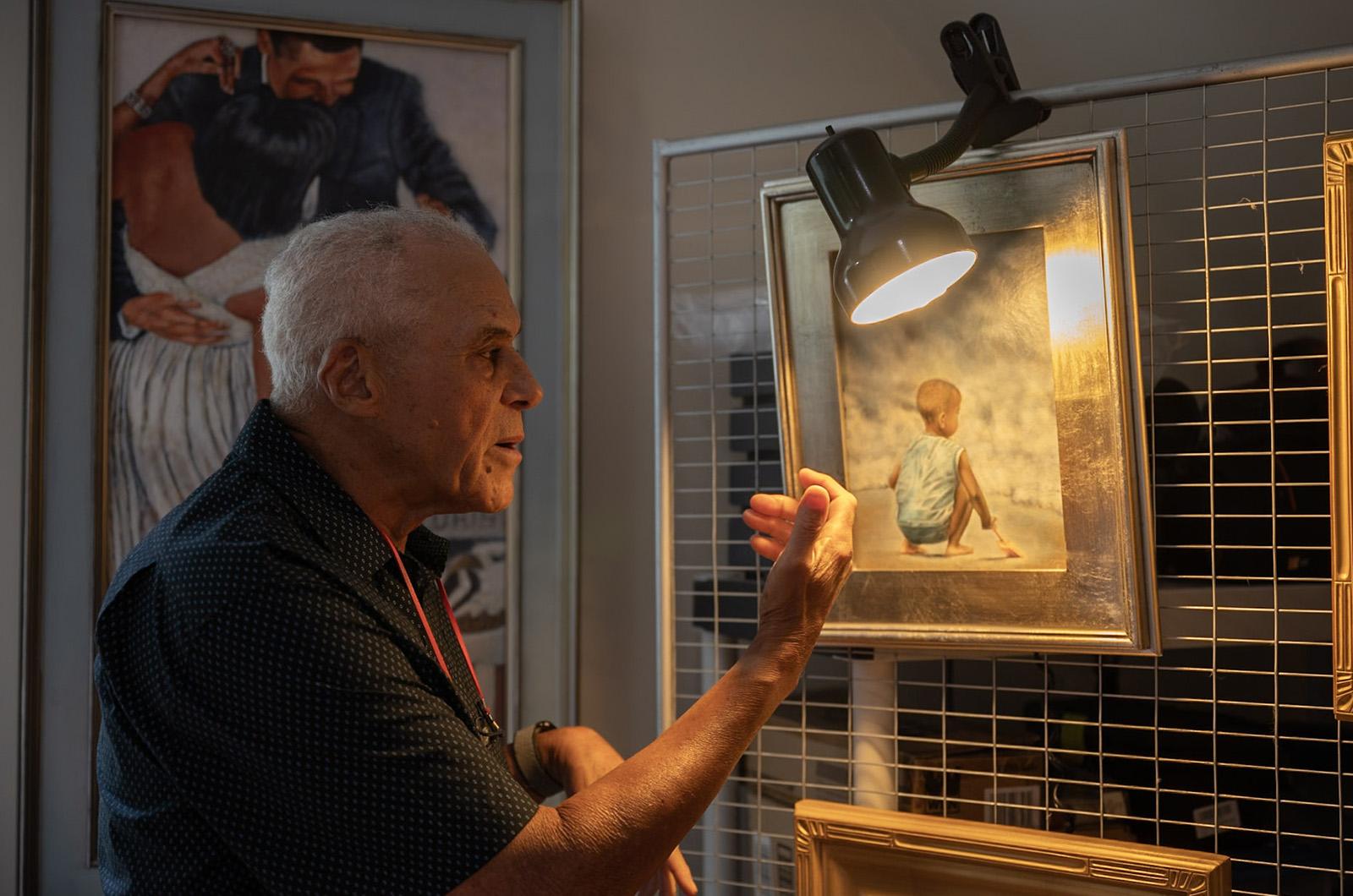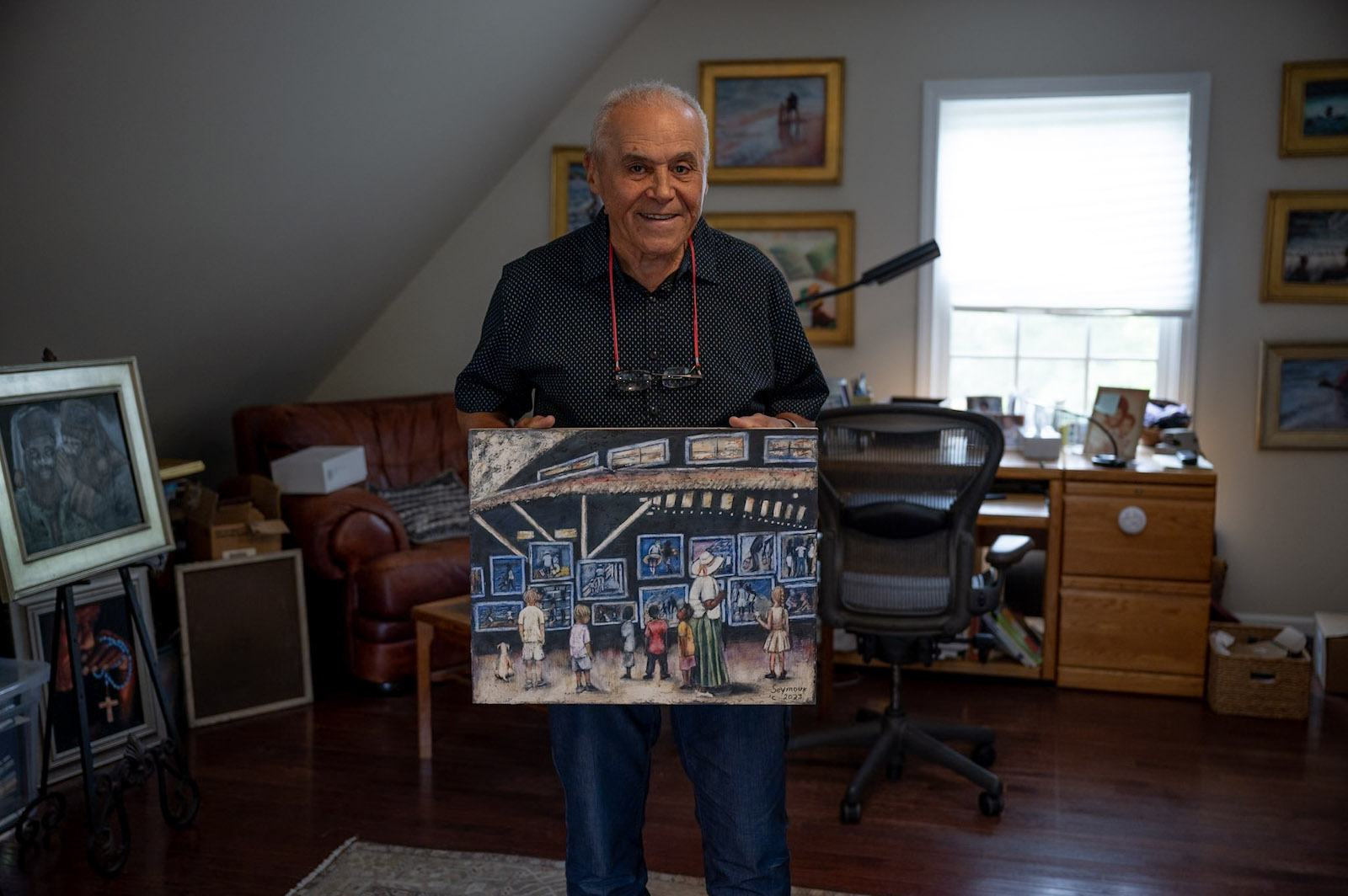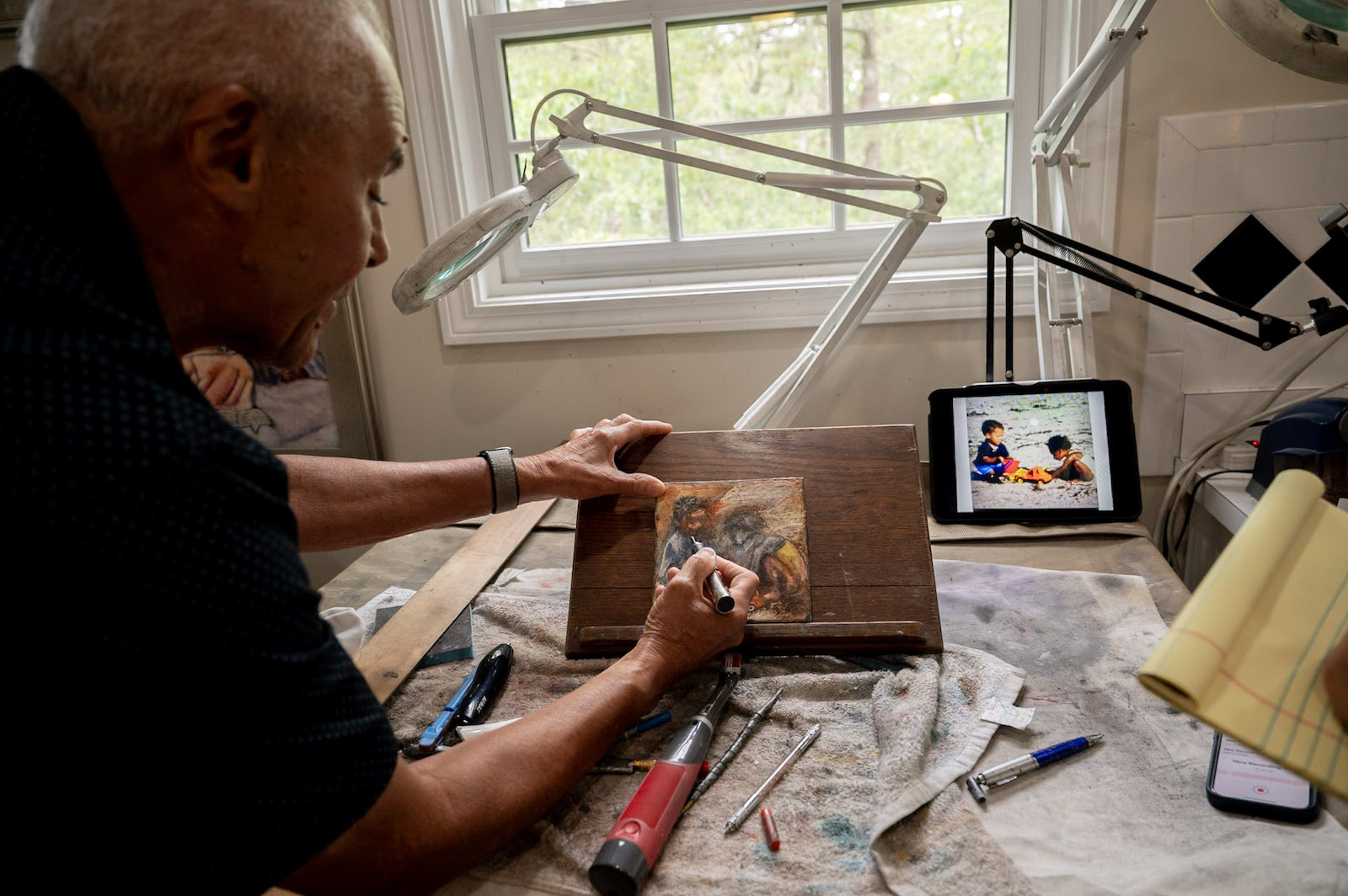There are paintbrushes in Harry’s Seymour art studio, about 50 or more in various sizes, shapes and thickness, but they sit on the sidelines resting idle by the sink in all manner of plastic containers.
Closer at hand are drill bits, razor blades, epoxy spreaders, tattoo needles and an assortment of hand-held vacuum cleaners.
“I create a lot of dust,” Mr. Seymour says as he picks up a grout cleaner and demonstrates his scratch art technique on a new piece. He calls his creative process the art of subtraction, scratching and grinding and re-shaping a canvas until it reveals the image he seeks.
“The classic way of working, there is a Masonite board covered with white china clay which is covered with black India ink,” he explains. “Take a sharp instrument, it could be a knife, it could be a dental tool, it could be a straight pin. When I started I tended to work solely in straight pin and I’d scratch the black surface and the white would reveal itself.”

It is a painstaking process, one that has evolved over time as Mr. Seymour dug deeper into the creative process of scratch art, discovering his own unique style. A recent piece, The Inkwell, took nearly three years to create. The image, along with a poem, will be part of a new exhibit at the Martha’s Vineyard Playhouse called Paintings and Poetry in Harmony. The exhibit opens July 3 and runs through August 10, with an opening reception on July 10 at 5 p.m.
His work, which is both art and commentary, appears regularly in the Gazette.
Mr. Seymour’s studio is located above the garage in the Oak Bluffs home he shares with his wife Charlena. His wife has been coming to the Vineyard since she was 10 years old and introduced him to the Island. It was love at first sight. The couple honeymooned on the Vineyard, bought a home and have been a part of the community for more than 50 years. They moved to the Island full time in 2010.
Mr. Seymour, 82, is a self-taught artist. He doodled on the side all his life but didn’t go all in until his sixties when he took early retirement from his long career as a professor of speech pathology at the University of Massachusetts Amherst.
Looking back on his life he acknowledges he never had a plan, preferring to let it unfold, one step at time. He grew up in Detroit and majored in business at Howard University, which is where he met his wife. After college he tried a career in retail but soon realized he didn’t have the temperament for the business world.
“Being in business and retailing, it was a kind of position that meant you were really confined. You were confined in a building,” he says. “It was a large building, but you were confined and focused on getting that cash register to ring as often as it could. And your progress and your assessment was based upon how well you did all of that.”
When deciding what to do next, he didn’t have far to look. His wife had been a theatre major in college but was now pursuing a master’s degree at Ohio State University in speech pathology.
“I looked at what she was doing and it appealed to me,” he says. “It appealed to me because they worked with people who had handicaps, communication disorders. And I said, ah, you know, I might like that. I liked the idea that I might be helping people.”
Mr. Seymour joined his wife in the master’s program and the two completed their PhD’s together in 1971 and then they both found jobs as professors at UMass, where Mr. Seymour spent his entire career.
For his academic research, Mr. Seymour tapped into his own childhood. His father died when Harry was 15 years old and the family grew up poor.
“We had some tough times starting out in government supported projects in Michigan,” he said.
His father had been a golfer, regarded as one of the top five Black golfers in the world at the time.
“But the key word there is Black,” he says. “Being a Black golfer in the United States, you were on the Chitlin’ Circuit. That was a group of Black tournaments and it was it was very isolated, very confined and not lucrative at all. In fact, the PGA didn’t really begin to admit Black golfers until 1964.”
This experience led Mr. Seymour to want to help Black children get ahead, to realize a sense of their purpose and possibility, something he felt his father didn’t have, nor did he initially. As a speech pathologist, he said he initially thought he would help Black students conform to the set of standards society proscribed in terms of how someone should talk to get ahead.
“I had this naive notion that I was going to be a speech language pathologist and correct all that bad speech, all that broken English, so that their opportunities would be improved,” he says.
But as he explored the subject, he began to see a pattern where Black students were being put into special education tracks in large percentages solely due to how they spoke.
“I discovered there was an overabundance of Black children, Black boys in particular, who were in these special education programs because of the way they spoke. But they didn’t need to be. It was more of a cultural thing, that they are speaking the way they did because of where they come from, how their culture had evolved over time. For example, if you go into Boston and you see all these white kids saying ‘paak the caa’ you think, what the heck happened to that R, but they don’t get put into special education programs.”
He continues: “So I spent pretty much my whole academic career, scholarly career, doing precisely that, trying to prepare students and broaden the understanding of the cultural dimensions of African American English.”
And in retirement, the journey continues through his art and his poetry.
“I’ve always been a kind of a maverick of sorts,” he says. “One of the reasons I was successful in working with Black kids and coming up with tests for them was that I tend to avoid the way everybody else does things. That strain is with me in terms of my art. No one else works the way I work in art.”
A relatively new development in the way he works is pairing a poem with his artwork, expanding and deepening the image with words.
“I will have an idea of an issue that I’m concerned about it, and it is mostly social and political. And I thought, well, if I match this poem with that painting, they both come together organically.”
It is a one-two punch of emotion that aims to educate and lead to dialogue rather than discord, he says, a natural evolution of his background and how he has lived his life.
“This whole thing about black and white in my family is kind of confusing, or I shouldn’t say confusing, but my sense of black and white is colored by my sense of a grandmother who is white and my son in law who is white. So when people talk to me about black and white, I, in a sense, recognize a dual consciousness and that there are no absolutes. There is gray and there is nuance.”
In The Inkwell, the painting is of the iconic Oak Bluffs beach, filled with Black bodies at rest on a summer’s day. The poem that accompanies it lifts up the long legacy of this safe space.
“Rooted in historical fact / With a richly endowed culture / Unforgettably Black / As if each grain of sand / Has a generational tale / Of Black bodies fused / In a legacy that remains / A place of congeniality / And the familial bond.”
Paintings and Poetry in Harmony by Harry Seymour opens at the Martha’s Vineyard Playhouse on July 3.







Comments (6)
Comments
Comment policy »